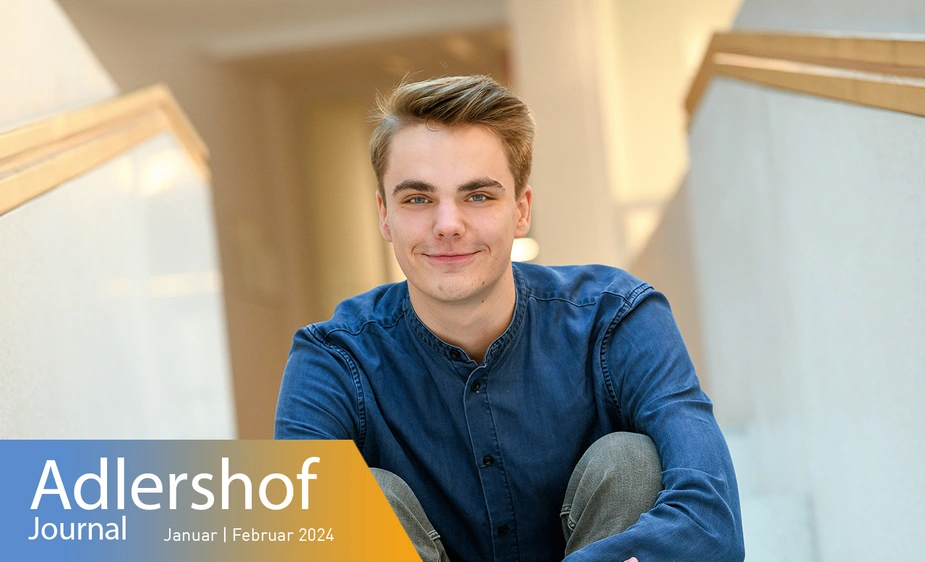Oustanding: STEM talent Maximilian Helmbrecht promotes STEM talent
Fischer Nernst Award winner from HU Chemistry is involved in the Humboldt ProMINT Kolleg
Maximilian Helmbrecht detected antioxidants in foodstuffs as part of his bachelor’s thesis and received the Fischer-Nernst Award of Humboldt-Universität zu Berlin (HU) for it. At the same time, the 23-year-old is making sure that new talents can grow in the STEM sector.
Maximilian Helmbrecht didn’t have a hard time deciding on HU because his unusual combination of subjects—geography and chemistry with teacher training—is only offered on the Adlershof Campus and nowhere else in Berlin. Helmbrecht’s passion for the natural sciences was sparked by his sister, who has a PhD in business chemistry. What intrigued him most about geography was the combination of physical and anthropogenic components. Climate change was a good example of this, he says.
Moreover, he takes care of up-and-coming talent at Humboldt-ProMINT-Kolleg, an interdisciplinary centre at HU. He is happy to contribute to getting young people passionate about science. “I enjoy analytical work because one derives a certain property from every type of structure.” This is also what he did in the thesis for his BA. “I created a filter paper test based on metal oxide nanoparticles to detect antioxidants in food samples.” In terms of handling, the test is quite similar to a COVID-19 lateral flow test. The sample is applied, the liquid is absorbed, and the test produces a colour reaction. Instead of a cassette, Helmbrecht uses a circular piece of filter paper that he dips in metal oxide nanoparticles, which are metals with one or more oxygen atoms. The number of oxygen atoms depends on the metal particle in the molecule.
Metal oxide nanoparticles are invisible to the human eye. “We can perceive anything on a scale of up to one millimetre quite well, but nanoparticles are much smaller. If you divide a millimetre into a million pieces, you get a nanometre.” The advantage of this minuscule entity is that it can be easily reduced through antioxidants. “Antioxidants, such as vitamin C, emit electrons, while the metal oxides absorb these electrons. By receiving electrons, the formal charge of the metal particle is reduced, the so-called oxidation number. This reduction of nanoparticles causes the colour change.”
When testing with cerium oxide nanoparticles, the filter paper turns brown if it contains antioxidants; when testing with iron oxide nanoparticles, the paper goes grey. Based on the intensity of the colour change, it is possible to measure how much antioxidants were in the sample. The darker the colour, the more antioxidant there is.
He first tested the reaction using a reference molecule, in this case, gallic acid. “This is an essential antioxidant that we ingest through food and require to carry out certain metabolic processes.” Gallic acid is found, for example, in blackberries, raspberries, and blackcurrants as well as green and black tea. After having optimised his test, Helmbrecht began examining foodstuffs. He used green tea and red wines from well-known brands. The result: Green tea has a higher antioxidant capacity than red wine.
Helmbrecht is glad that his experiment worked. “In science, it happens very often that you try something and it doesn’t work. Then, somehow, you have to find an explanation why it didn’t.” Since his final thesis also convinced the prize jury of the HU’s Department of Chemistry, Maximilian Helmbrecht is scheduled to receive the Fischer-Nernst Award on 14 February 2024.
Helmbrecht is currently working on his master’s thesis in chemistry didactics on how young people learn best from the perspective of a teacher. “I have looked at this already during my BA and now I want to do so in greater detail because the question is intriguing and cannot be answered in a generalised way.”
Until the end of January 2024, Maximilian Helmbrecht will now be teaching an eighth and tenth-grade class at a STEM high school two to three times a week as part of a six-month internship in Spandau Siemensstadt under the guidance of mentors. When asked whether his pupils realise that they are dealing with an award-winning teacher, he replies with a laugh: “No, and I intend to keep it that way. The focus shouldn’t be on me as a person but on the students.”
Susanne Gietl for Adlershof Journal
